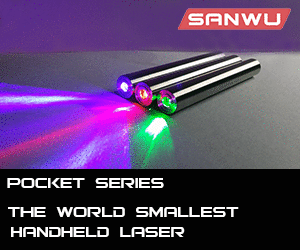
Welcome to Laser Pointer Forums - discuss green laser pointers, blue laser pointers, and all types of lasers
How to Register on LPF | LPF Donations
Navigation
Install the app
How to install the app on iOS
Follow along with the video below to see how to install our site as a web app on your home screen.
Note: This feature may not be available in some browsers.
More options

You are using an out of date browser. It may not display this or other websites correctly.
You should upgrade or use an alternative browser.
You should upgrade or use an alternative browser.
what laser should i buy (beginner)
- Thread starter mike4
- Start date


julianthedragon
Well-known member
- Joined
- Jun 3, 2020
- Messages
- 375
- Points
- 63
If you're a beginner then I would recommend not starting with a burning laser at all. How old are you?
Also I can't speak on amazon or aliexpress sellers but some trusted companies here are Laserglow, Sanwu, and JetLasers
Also I can't speak on amazon or aliexpress sellers but some trusted companies here are Laserglow, Sanwu, and JetLasers
julianthedragon
Well-known member
- Joined
- Jun 3, 2020
- Messages
- 375
- Points
- 63
Ok gotcha. Well first I'd get familiar with power (mW) and wavelength (nm) if you're not already.
Here are a couple sources to give you some intuition on laser power and common wavelengths:
https://www.htpow.com/blog/bid-10.html ; http://laserkids.sourceforge.net/eng_tablica.html
You're an adult and can do what you like but my recommendation is starting small and building your way up to a strong burner. Keep in mind the limit to sell in most jurisdictions is 5mw, which is about the strength of your average presentation pointer, though it's usually legal to own any power. For a basic intro pointer that doesn't burn, Laserglow is a great source.
***If you purchase anything above 5mw, and especially above 50mw, you must also order the appropriate safety glasses. Order from here and make sure to pick glasses that cover the wavelength of your laser: https://www.laserglow.com/product/byproduct/Laser-Safety-Goggles/ *** Full safety guide: https://www.laserpointersafety.com/
Burning is mostly about power, or more accurately power density—power divided by area—which means you need to focus to a small dot for burning. JetLasers and Sanwu both sell powerful lasers with focusing threads that can burn. For a laser that will still pack a punch without the risk of the ultra high powered options, I would go with a pocket laser from Sanwu between 50mw-150mw. At this level you still should wear safety glasses but you can practice focusing it to pop balloons, light a match, and maybe cut black electrical tape or something. I have Sanwu's 50mW 520nm pocket laser and it still smokes surfaces when focused in.
If you do decide to go for a more powerful burning laser you can't go wrong with JetLasers or Sanwu. I'm not going to recommend a specific laser but look into JetLaser's PL-E and Sanwu's Challenger II, Striker, Silver, and Guardian series. These companies are pricier than others but you're paying for great construction, parts, customer service, and accurate power ratings which are super important especially for a beginner.
FYI, wavelength is essentially the color of the laser and only affects burning ability in special situations. e.g. complimentary colors burn well, so a 405nm violet laser would burn something green for example, but all colors should burn a black object equally. Intuitively, it will burn better if the material absorbs more light, and black objects absorb all visible light.
Do your research and use responsibly, good luck
Here are a couple sources to give you some intuition on laser power and common wavelengths:
https://www.htpow.com/blog/bid-10.html ; http://laserkids.sourceforge.net/eng_tablica.html
You're an adult and can do what you like but my recommendation is starting small and building your way up to a strong burner. Keep in mind the limit to sell in most jurisdictions is 5mw, which is about the strength of your average presentation pointer, though it's usually legal to own any power. For a basic intro pointer that doesn't burn, Laserglow is a great source.
***If you purchase anything above 5mw, and especially above 50mw, you must also order the appropriate safety glasses. Order from here and make sure to pick glasses that cover the wavelength of your laser: https://www.laserglow.com/product/byproduct/Laser-Safety-Goggles/ *** Full safety guide: https://www.laserpointersafety.com/
Burning is mostly about power, or more accurately power density—power divided by area—which means you need to focus to a small dot for burning. JetLasers and Sanwu both sell powerful lasers with focusing threads that can burn. For a laser that will still pack a punch without the risk of the ultra high powered options, I would go with a pocket laser from Sanwu between 50mw-150mw. At this level you still should wear safety glasses but you can practice focusing it to pop balloons, light a match, and maybe cut black electrical tape or something. I have Sanwu's 50mW 520nm pocket laser and it still smokes surfaces when focused in.
If you do decide to go for a more powerful burning laser you can't go wrong with JetLasers or Sanwu. I'm not going to recommend a specific laser but look into JetLaser's PL-E and Sanwu's Challenger II, Striker, Silver, and Guardian series. These companies are pricier than others but you're paying for great construction, parts, customer service, and accurate power ratings which are super important especially for a beginner.
FYI, wavelength is essentially the color of the laser and only affects burning ability in special situations. e.g. complimentary colors burn well, so a 405nm violet laser would burn something green for example, but all colors should burn a black object equally. Intuitively, it will burn better if the material absorbs more light, and black objects absorb all visible light.
Do your research and use responsibly, good luck

